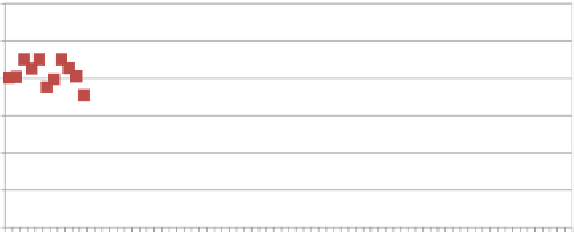Environmental Engineering Reference
In-Depth Information
CODin (mg/L)
CODout (mg/L)
12000
10000
8000
6000
4000
2000
0
1
11
21
31
41
51
61
71
Days
Fig. 4
CODproileoverthetrialperiod
Upflow velocity is regarded as one of the key parameter significantly affecting
microbial ecology and characteristics of UASBR. It also helps in flushing the haz-
ardous gases thereby keeping the system in healthy condition. The optimum upflow
velocity for the wastewater and the system under study was found to be 0.5 m/h. In
ordertomaintainthedesiredOLRanduplowvelocity,thefeedtoUASBRis4-5
times of the influent and hence the same was recycled back to buffer tank/UASBR
feed tank. This also helps in minimizing the toxicity and shock load to UASBR.
TheCODreductionintheinitialphaseofthestartupwasonthehighersidedue
tohigherpercentageofCODfromthejaggerywhichiseasilybiodegradable.COD
reduction stabilized to 47-50 % (Fig.
4
) which was desired by the manufacturing
facility.CODreductionof90-95%wasachievedwiththecombinationofanaero-
bic followed by aerobic reactor, whereas only 85-90 % of COD reduction was
observed with two-stage aerobic reactor. This may be due to presence of facultative
micro organisms present in the reactor which releases certain enzymes which are
able to convert high molecular aliphatic/aromatic compounds into smaller linear
chainmoleculeswhichareeasilybiodegradable(SinghandChoubey
2012
). Based
on pilot plant observations, full scale plant was designed.
Cost Economics
The manufacturing unit was planning to increase the production of IX resins, which
will lead to increase in flow as well as organic load to the ETP. The expansion of
the manufacturing facility will lead to increase in the flow to ETP from 180 m
3
/day
to 240 m
3
/daywithmarginalornochangeintheCODandBOD.Acostcompari-
son of UASBR against installation of an aerobic reactor was carried out which is
presented in Table
2
.




























































Search WWH ::

Custom Search